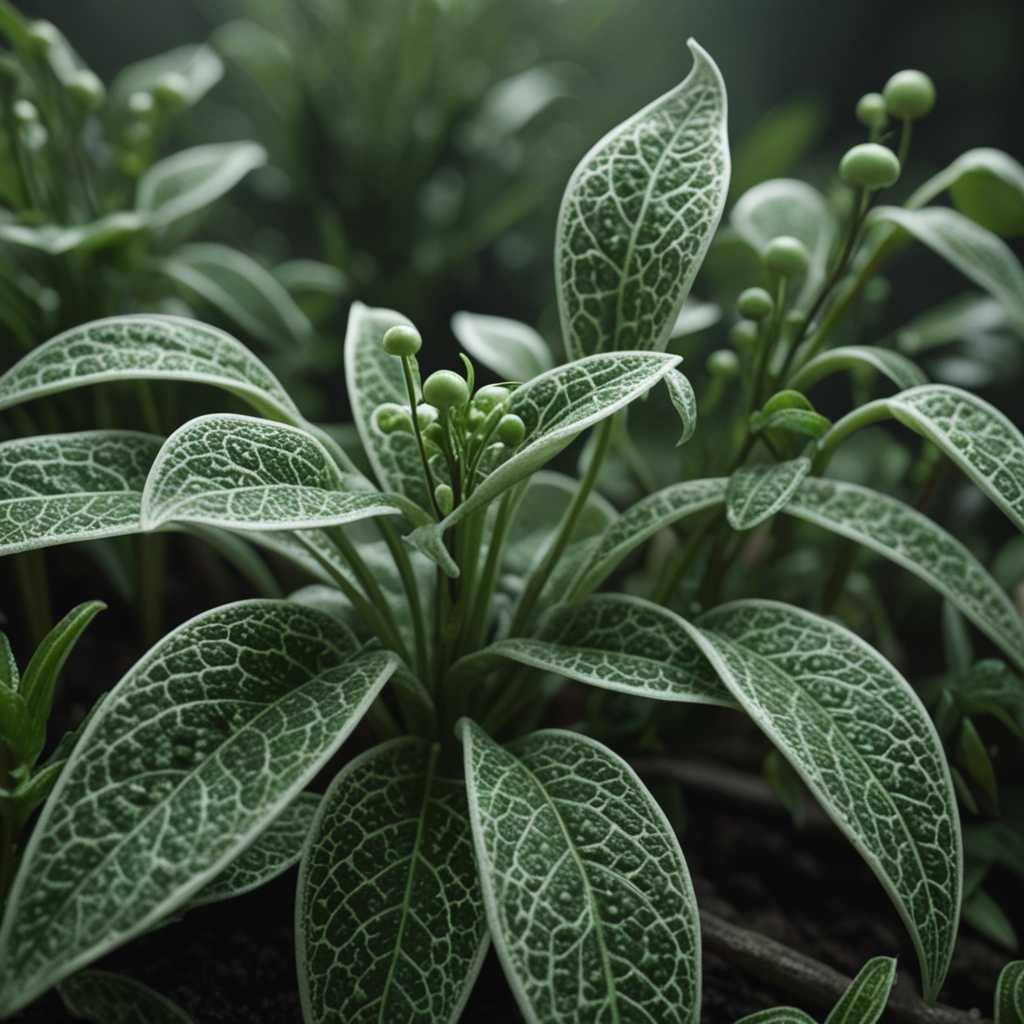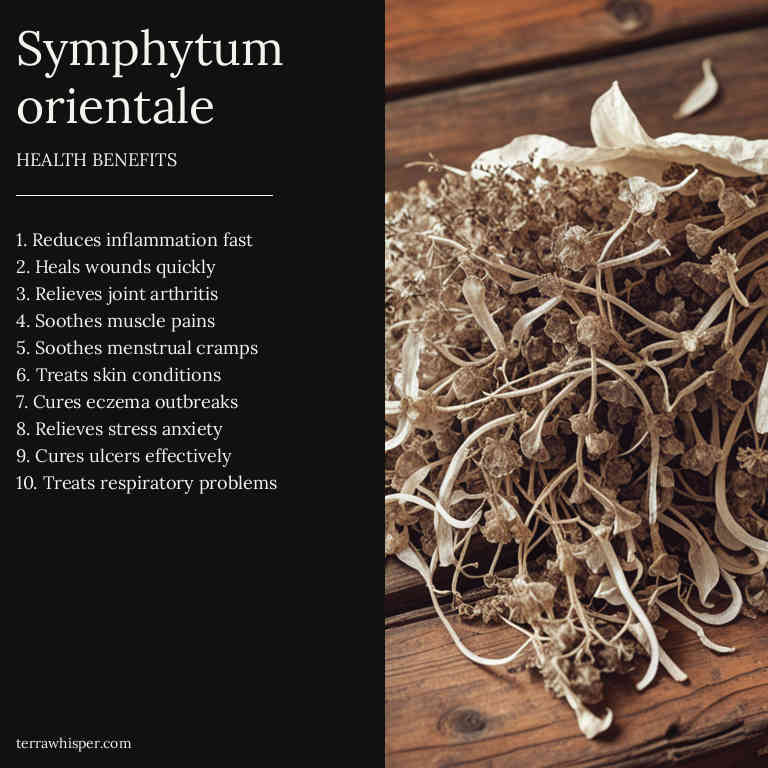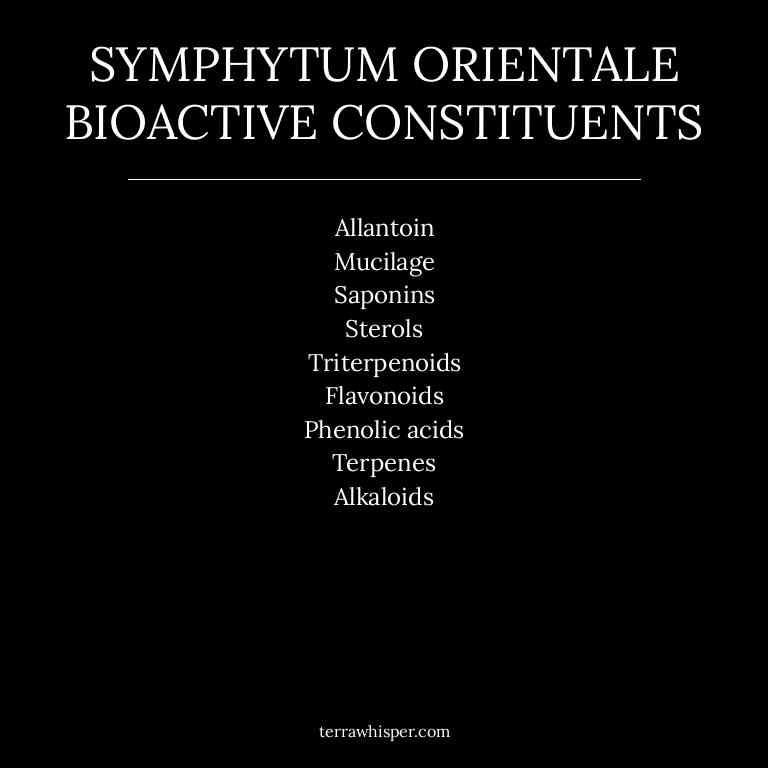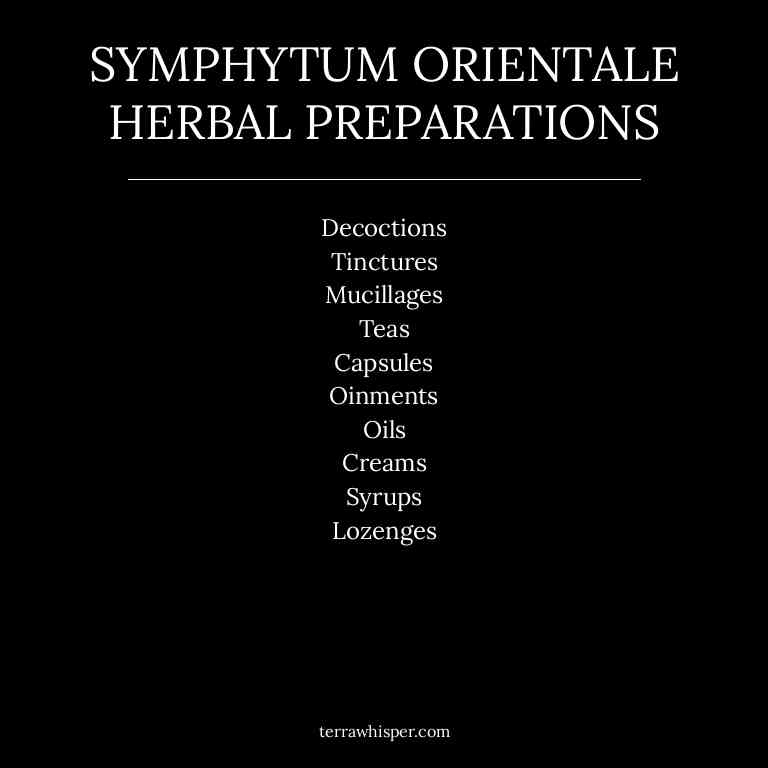Symphytum Orientale Uses, Benefits, And Remedies

Symphytum orientale, commonly known as the common comfrey, is a perennial herb belonging to the Boraginaceae family, known for its large, hairy leaves and violet-like flowers.
This herb has been traditionally used for its healing properties, particularly in supporting bone and tissue repair.
The bioactive constituents in Symphytum orientale include allantoin, mucilage, and various alkaloids, which contribute to its anti-inflammatory, wound-healing, and soothing effects.
It can be prepared as an infusion, poultice, or tincture, though internal use should be approached with caution due to potential toxicity.
This page analize the most important medicinal aspects of Symphytum orientale.
- Health Benefits
- Bioactive Constituents
- Medicinal Parts
- Herbal Preparations
- Side Effects of symphytum orientale
Health Benefits
Symphytum orientale reduces inflammation fast due to its high concentration of allantoin and mucilage, which work together to soothe irritated tissues and promote the body's natural healing processes.
It heals wounds quickly because the mucilage forms a protective layer over the wound, preventing infection and encouraging cell regeneration. It relieves joint arthritis by inhibiting the production of inflammatory enzymes like cyclooxygenase, thereby reducing pain and swelling in the joints. It soothes muscle pains by acting as a natural analgesic and improving blood circulation, which helps remove toxins and deliver nutrients to the affected areas.
It soothes menstrual cramps by relaxing uterine muscles and reducing prostaglandin activity, which is responsible for uterine contractions and pain during menstruation.
The 10 best health benefits of Symphytum orientale are shown in the image below.

The list below give a brief description of the 10 best health benefits of Symphytum orientale.
- Reduces Inflammation Fast: Symphytum orientale contains compounds that help reduce inflammation in the body, providing quick relief from swelling and irritation.
- Heals Wounds Quickly: This herb promotes rapid wound healing by stimulating tissue regeneration and enhancing the body's natural repair processes.
- Relieves Joint Arthritis: Symphytum orientale has anti-inflammatory properties that can alleviate joint pain and stiffness associated with arthritis.
- Soothes Muscle Pains: The herb helps relieve muscle pain and soreness by reducing inflammation and promoting muscle recovery.
- Soothes Menstrual Cramps: Symphytum orientale can ease menstrual cramps by reducing uterine inflammation and spasms.
- Treats Skin Conditions: It has soothing and healing properties that can treat various skin conditions like rashes and irritations.
- Cures Eczema Outbreaks: The herb's anti-inflammatory and antiseptic properties help reduce eczema symptoms and promote skin healing.
- Relieves Stress Anxiety: Symphytum orientale may help reduce stress and anxiety by balancing the nervous system and promoting relaxation.
- Cures Ulcers Effectively: It helps heal ulcers by protecting the stomach lining and reducing acid secretion.
- Treats Respiratory Problems: The herb can alleviate respiratory issues by reducing inflammation and clearing airway congestion.
Bioactive Constituents
Symphytum orientale allantoin is a key medicinal constituent known for its ability to promote wound healing and skin regeneration.
This compound helps in reducing inflammation and irritation, making it beneficial for treating skin conditions such as eczema and psoriasis. In addition to allantoin, Symphytum orientale contains mucilage, which acts as a soothing agent and helps in maintaining moisture in the skin and mucous membranes.
Saponins present in the herb have mild cleansing properties and can aid in detoxifying the body by supporting the liver and digestive system. Furthermore, sterols found in Symphytum orientale contribute to the herb's anti-inflammatory and immunomodulatory effects, enhancing its overall therapeutic potential.
These constituents work synergistically to provide a range of health benefits, from skin healing to internal support, making Symphytum orientale a valuable herb in traditional and modern medicine.
The 9 best bioactive constituents of Symphytum orientale are shown in the image below.

The list below give a brief description of the 10 best bioactive constituents of Symphytum orientale.
- Allantoin: Known for its soothing and healing properties, allantoin helps in the repair of skin and mucous membranes, and may reduce inflammation and irritation.
- Mucilage: A gel-like substance that acts as a demulcent, providing a protective coating to mucous membranes and helping to soothe irritation and inflammation.
- Saponins: These compounds have surfactant properties, helping to cleanse and detoxify the body, and may also exhibit anti-inflammatory and antimicrobial effects.
- Sterols: Known for their anti-inflammatory and skin-soothing properties, sterols can help in reducing irritation and promoting skin health.
- Triterpenoids: These compounds have anti-inflammatory, immunomodulatory, and antioxidant properties, contributing to the herb's therapeutic effects.
- Flavonoids: Act as antioxidants and anti-inflammatory agents, helping to protect cells from damage and reduce inflammation in the body.
- Phenolic Acids: These have antioxidant and anti-inflammatory properties, helping to neutralize free radicals and reduce oxidative stress in the body.
- Terpenes: Known for their antimicrobial, anti-inflammatory, and analgesic properties, terpenes contribute to the herb's overall therapeutic profile.
- Alkaloids: These compounds may have various effects including anti-inflammatory, analgesic, and possibly antimicrobial properties, contributing to the herb's medicinal value.
Medicinal Parts
Symphytum orientale root is one of the most valued medicinal parts of this plant, traditionally used for its potent healing properties.
The root contains high concentrations of allantoin, a compound known for its ability to promote cell proliferation and tissue repair, making it effective in treating wounds, inflammation, and skin conditions. It has also been used historically to alleviate pain and reduce swelling, particularly in cases of arthritis and musculoskeletal injuries.
In addition to its root, the leaves of Symphytum orientale are also utilized in herbal medicine, often prepared as a poultice or decoction to soothe skin irritations and reduce inflammation. The flowers and fruit, while less commonly used, contribute to the plant's overall medicinal profile, with the flowers sometimes employed in tinctures for their mild sedative and anti-inflammatory effects.
Overall, the various parts of Symphytum orientale offer a range of therapeutic benefits, highlighting its importance in traditional and complementary medicine.
Herbal Preparations
Symphytum orientale decoctions are made by simmering the dried root or leaves in water for an extended period, allowing the active compounds to be extracted.
This preparation is commonly used for its purported healing properties, particularly for digestive and respiratory ailments. Tinctures, on the other hand, are concentrated alcohol-based extracts that offer a more potent and longer-lasting effect, often used for internal or external applications. Mucillages, derived from the plant's gel-like substance, are used to soothe irritated tissues and can be found in poultices or topical applications.
Teas made from Symphytum orientale are typically consumed to support gut health, while capsules provide a convenient and standardized dosage for daily use. Ointments and creams infused with the herb are applied topically to treat skin conditions or muscle pain, and syrups or lozenges may be used for respiratory support. Liniments, often combined with other herbs, are used to alleviate joint or muscle discomfort, while poultices made from fresh plant material can be applied directly to wounds or inflamed areas.
Each preparation method harnesses different properties of Symphytum orientale, offering a range of therapeutic applications in traditional herbal medicine.
The 10 best herbal preparations of Symphytum orientale are shown in the image below.

The list below give a brief description of the 10 best herbal preparations of Symphytum orientale.
- Decoctions: Symphytum orientale decoctions are used to support bone and tissue repair, often for fractures and wounds due to their anti-inflammatory and regenerative properties.
- Tinctures: Tinctures of Symphytum orientale are utilized for their analgesic and anti-inflammatory effects, commonly used for muscle pain and joint inflammation.
- Mucillages: Mucillages derived from Symphytum orientale are used to soothe and protect mucous membranes, aiding in digestive and respiratory tract conditions.
- Teas: Symphytum orientale teas are traditionally used to reduce inflammation, support healing of wounds, and alleviate symptoms of respiratory infections.
- Capsules: Capsules of Symphytum orientale provide a convenient form for internal use, supporting bone health and tissue regeneration with its active compounds.
- Oinments: Ointments made from Symphytum orientale are applied topically to treat bruises, sprains, and skin irritations due to their soothing and healing properties.
- Oils: Symphytum orientale oils are used in topical applications to reduce inflammation and promote healing of minor cuts, burns, and skin conditions.
- Creams: Creams containing Symphytum orientale are used to alleviate pain and inflammation in muscles and joints, and to support skin healing.
- Syrups: Symphytum orientale syrups are used to soothe coughs and respiratory discomfort, leveraging their expectorant and anti-inflammatory properties.
- Lozenges: Lozenges of Symphytum orientale are used to relieve sore throats and inflammation in the mouth and throat due to their mucilage content.
Side Effects of symphytum orientale
Symphytum orientale results in nausea due to its high content of compounds like saponins, which can irritate the stomach lining and slow gastric emptying.
Symphytum orientale leads to vomiting because the same irritant compounds may stimulate the vomiting reflex in the body. Symphytum orientale causes stomach upset as it can disrupt normal digestive processes and increase gut motility.
Symphytum orientale triggers allergic reactions in some individuals due to the presence of allergenic proteins that may provoke an immune response.
The 11 most common side effects of Symphytum orientale are shown in the image below.

The list below give a brief description of the 11 most common side effects of Symphytum orientale.
- Results In Nausea: Symphytum orientale may cause feelings of queasiness or an upset stomach, particularly when consumed in high doses or by individuals sensitive to its compounds.
- Leads To Vomiting: In some cases, the herb may provoke vomiting, likely due to its irritant properties on the digestive system.
- Causes Stomach Upset: Symphytum orientale can irritate the stomach lining, leading to discomfort, bloating, or cramping.
- Triggers Allergic Reaction: Individuals with allergies to related plants may experience an allergic reaction upon exposure to Symphytum orientale.
- Causes Breathing Difficulty: In severe cases, the herb may lead to respiratory issues, including difficulty breathing, particularly in those with heightened sensitivity.
- Induces Skin Irritation: Contact with the plant may cause skin irritation, redness, or a burning sensation due to its chemical composition.
- Causes Muscle Weakness: Symphytum orientale may interfere with muscle function, leading to temporary weakness, especially in high doses.
- Leads To Skin Rash: The herb can cause a rash or skin reaction, often characterized by redness, itching, or hives.
- Induces Gastrointestinal Pain: Symphytum orientale may cause pain in the digestive tract, including stomach or intestinal discomfort.
- Brings About Dizziness: The herb may cause dizziness or lightheadedness, possibly due to its effects on the nervous system or blood pressure.
- Results In Headaches: Symphytum orientale can trigger headaches, potentially due to its impact on blood vessels or neurotransmitter activity.